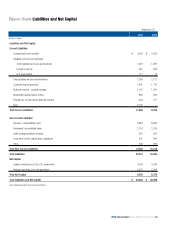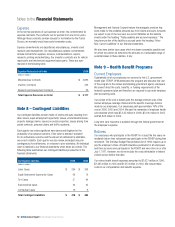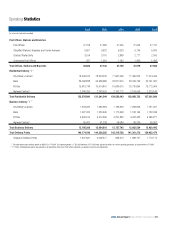US Postal Service 2006 Annual Report Download - page 54
Download and view the complete annual report
Please find page 54 of the 2006 US Postal Service annual report below. You can navigate through the pages in the report by either clicking on the pages listed below, or by using the keyword search tool below to find specific information within the annual report.
52 | 2006 Annual Report United States Postal Service
Expense
In the normal operations of our business we enter into commitments for
expense contracts. The contracts run for periods from one to ten years.
Although these contracts contain clauses for termination by the Postal
Service, we normally would have early termination costs.
Expense commitments are classified as miscellaneous, inventory and
research and development. Our miscellaneous expense commitments
include contracts for supplies, services, communications, repairs,
research, printing and advertising. Our inventory contracts are for vehicle
repair parts and mechanized equipment spare parts. These are sum-
marized in the following table.
Expense Resources on Order 2006
(Dollars in millions)
Miscellaneous Contracts $ 4,885
Inventory Contracts 253
Research and Development Contracts 39
Total Expense Resources on Order $ 5,177
Note 8 – Contingent Liabilities
Our contingent liabilities consist mainly of claims and suits resulting from
labor issues, equal employment opportunity issues, environmental issues,
property damage claims, injuries on postal properties, issues arising from
postal contracts, personal claims and traffic accidents.
Each quarter we review significant new claims and litigation for the
probability of an adverse outcome. If the claim is deemed “probable”
for an unfavorable outcome and the amount of settlement is estimable,
we record a liability. Each quarter we also review and adjust any prior
contingencies for settlements, or revisions to prior estimates. No individual
claim is material to our financial statements when taken as a whole. The
following table summarizes our contingent liabilities provided for in the
financial statements.
Contingent Liabilities 2006 2005
(Dollars in millions)
Labor Cases $ 254 $ 308
Equal Employment Opportunity Cases 66 79
Tort Cases 57 49
Environmental Cases 25 25
Contractual Cases 16 8
Total Contingent Liabilities $ 418 $ 469
Management and General Counsel believe that adequate provision has
been made for the probable amounts due from claims and suits. Amounts
we expect to pay in the next year are current liabilities on the balance
sheets under the heading “Trade payables and accrued expenses.” The
long-term portion of the liability is accrued under the heading “Other
Non-Current Liabilities” in our financial statements.
We also have similar type cases which we deem reasonably possible and
for which we cannot yet determine the amounts or a reasonable range of
potential losses in these matters, if any.
Note 9 – Health Benefit Programs
Current Employees
Substantially all of our employees are covered by the U.S. government
health plan, FEHBP. OPM administers the program and allocates the cost
of the program to the various participating government agency employers.
We cannot direct the costs, benefits, or funding requirements of the
federally-sponsored plan and therefore are required to use multi-employer
plan accounting rules.
Our portion of the cost is based upon the average premium cost of the
various employee coverage choices and the specific coverage choices
made by our employees. Our employees paid approximately 16% of the
cost in 2006, 2005 and 2004. We paid the remainder of employee health
care expense which was $5,345 million in 2006; $5,100 million in 2005
and $4,845 million in 2004.
Long term care insurance is available through the federal government at
the employee’s expense.
Retirees
Our employees who participate in the FEHBP for at least the five years im-
mediately before their retirement may participate in the FEHBP during their
retirement. The Omnibus Budget Reconciliation Act of 1990 requires us to
pay the employer’s share of health insurance premiums for all employees
and their survivors who participate in the FEHBP and who retire on or after
July 1, 1971. However, we do not include the costs attributable to federal
civilian service before that date.
Our retiree health benefit expenses amounted to $1,637 million in 2006;
$1,495 million in 2005 and $1,313 million in 2004. We include these
costs in our compensation and benefits expense.
Notes to the Financial Statements
























